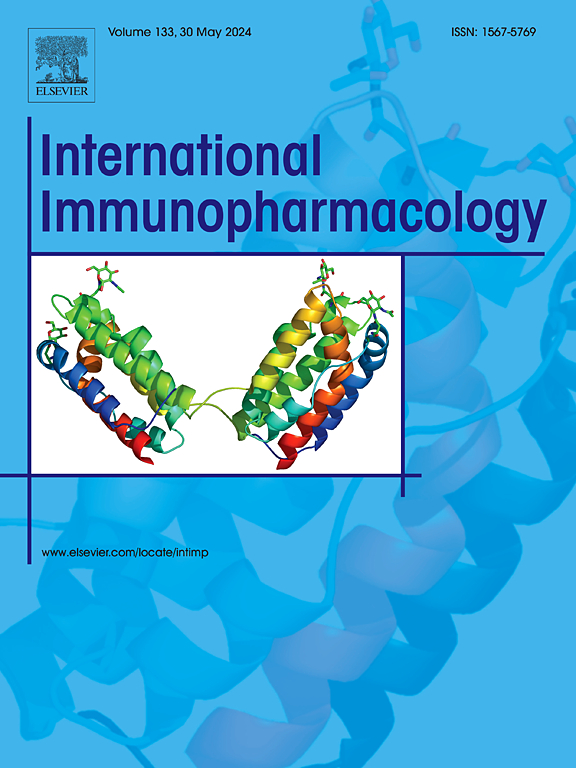天叶肽- gha衍生肽对痤疮角质杆菌有抑制作用,减轻寻常痤疮的炎症反应
IF 4.8
2区 医学
Q2 IMMUNOLOGY
引用次数: 0
摘要
寻常痤疮是一种广泛存在的慢性炎症性皮肤病,主要由痤疮表皮杆菌感染和随后的炎症引起。Temporin-GHaR4G7R (GHaR4G7R)来源于蛙类Hylarana guentheri的Temporin-GHa。对其体外和体内抑菌性能及对寻常痤疮的潜在作用机制进行了评价。体外实验表明,GHaR4G7R对痤疮C.具有较强的杀菌作用,最小抑菌浓度(MIC)和最小杀菌浓度(MBC)均为3.1 μM。它通过破坏细菌膜来发挥抗菌作用,并且产生耐药性的倾向较低。GHaR4G7R通过减少胞外多糖的合成,显著抑制了C. acnes早期生物膜的形成,并消除了已形成的生物膜。同时,通过qRT-PCR、免疫荧光和Western blot检测,GHaR4G7R通过显著下调TLR2/NF-κB/MAPK通路相关蛋白的表达,对热灭活C. acat细胞具有抗炎作用。正如预期的那样,GHaR4G7R通过抑制TLR2/NF-κB/MAPK信号通路,显著降低了痤疮c诱导的大鼠耳模型中的细菌定植,减轻了耳廓肿胀和炎症细胞浸润,从而在体内下调炎症细胞因子表达,减轻皮肤炎症。该研究表明,GHaR4G7R可能是开发治疗寻常痤疮新策略的潜在替代方案。本文章由计算机程序翻译,如有差异,请以英文原文为准。

Temporin-GHa derived peptide shows inhibitory efficacy against Cutibacterium acnes and alleviates inflammatory reactions in acne vulgaris
Acne vulgaris is a widespread chronic inflammatory skin disease that is mainly caused by Cutibacterium acnes infection and subsequent inflammation. Temporin-GHaR4G7R (GHaR4G7R) was derived from Temporin-GHa of frog Hylarana guentheri. Its antibacterial performance against C. acnes and potential mechanism against acne vulgaris in vitro and in vivo were evaluated. In vitro tests demonstrated that GHaR4G7R displayed potent bactericidal effects against C. acnes, with both the minimum inhibitory concentration (MIC) and minimum bactericidal concentration (MBC) of 3.1 μM. It exerted antibacterial effect by disrupting the bacterial membranes, accompanied by low propensity for developing drug resistance. GHaR4G7R significantly inhibited the formation of early biofilms and eliminated established biofilms of C. acnes by decreasing exopolysaccharide synthesis. Meanwhile, GHaR4G7R demonstrated an anti-inflammatory effect on HaCaT cells challenged with heat-inactivated C. acnes by significantly down-regulating the expression of TLR2/NF-κB/MAPK pathway-associated proteins by qRT-PCR, immunofluorescence, and Western blot assays. As expected, GHaR4G7R significantly decreased the bacterial colonization in rat ear model induced by C. acnes, and relieved the auricular swelling and inflammatory cell infiltration through inhibiting the TLR2/NF-κB/MAPK signaling pathway, leading to down-regulation of the inflammatory cytokine expression and alleviation of the skin inflammation in vivo. The research indicates that GHaR4G7R might be a potential alternative for developing novel strategies for treating acne vulgaris.
求助全文
通过发布文献求助,成功后即可免费获取论文全文。
去求助
来源期刊
CiteScore
8.40
自引率
3.60%
发文量
935
审稿时长
53 days
期刊介绍:
International Immunopharmacology is the primary vehicle for the publication of original research papers pertinent to the overlapping areas of immunology, pharmacology, cytokine biology, immunotherapy, immunopathology and immunotoxicology. Review articles that encompass these subjects are also welcome.
The subject material appropriate for submission includes:
• Clinical studies employing immunotherapy of any type including the use of: bacterial and chemical agents; thymic hormones, interferon, lymphokines, etc., in transplantation and diseases such as cancer, immunodeficiency, chronic infection and allergic, inflammatory or autoimmune disorders.
• Studies on the mechanisms of action of these agents for specific parameters of immune competence as well as the overall clinical state.
• Pre-clinical animal studies and in vitro studies on mechanisms of action with immunopotentiators, immunomodulators, immunoadjuvants and other pharmacological agents active on cells participating in immune or allergic responses.
• Pharmacological compounds, microbial products and toxicological agents that affect the lymphoid system, and their mechanisms of action.
• Agents that activate genes or modify transcription and translation within the immune response.
• Substances activated, generated, or released through immunologic or related pathways that are pharmacologically active.
• Production, function and regulation of cytokines and their receptors.
• Classical pharmacological studies on the effects of chemokines and bioactive factors released during immunological reactions.

 求助内容:
求助内容: 应助结果提醒方式:
应助结果提醒方式:


